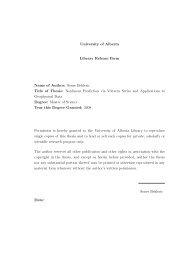Regularization of the AVO inverse problem by means of a ...
Regularization of the AVO inverse problem by means of a ...
Regularization of the AVO inverse problem by means of a ...
Create successful ePaper yourself
Turn your PDF publications into a flip-book with our unique Google optimized e-Paper software.
CHAPTER 2. <strong>AVO</strong> MODELING 11<br />
(S-wave reflected), <strong>the</strong> transmitted P-wave, and converted wave upon transmission (S-wave<br />
transmitted) be represented <strong>by</strong> φ1, ψ1, φ2, and ψ2 respectively. Indices 1 and 2 indicate <strong>the</strong><br />
upper and lower layers respectively. The plane wave solutions to equations (2.1) and (2.2)<br />
according to <strong>the</strong> transformation shown in Figure 2.1, we have<br />
φ1 = A0e iω(px+ cos θi cos θr<br />
α z−t) iω(px−<br />
1 α z−t)<br />
+ A1e 1 ,<br />
cos ϕr<br />
iω(px− β z−t)<br />
ψ1 = B1e 1 ,<br />
φ2 = A2e iω(px+ cos θ t<br />
α 2 z−t) ,<br />
ψ2 = B2e iω(px+ cos ϕ t<br />
β 2 z−t) , (2.3)<br />
where A0, A1, B1, A2 and B2 are <strong>the</strong> wave amplitudes for <strong>the</strong> incident P-wave, reflected<br />
P-wave, reflected S-wave (converted upon reflection), transmitted P-wave and transmitted<br />
S-wave (converted P-wave upon transmission) respectively. The parameters p and ω are ray<br />
parameter and frequency respectively. The angles θi, θr, θt are <strong>the</strong> incidence, reflection and<br />
transmission angles <strong>of</strong> <strong>the</strong> P-wave respectively. The remaining angles ϕr and ϕt are <strong>the</strong><br />
reflection and transmission angles for S -waves respectively (refer Figure 2.1).<br />
To proceed fur<strong>the</strong>r, we need to write Snell’s law in terms <strong>of</strong> <strong>the</strong> angles and velocities <strong>of</strong> <strong>the</strong><br />
media. The apparent velocity along <strong>the</strong> interface between <strong>the</strong> two layers is constant<br />
cx = 1 α1<br />
= =<br />
p sin θi<br />
β1<br />
sin ϕr<br />
= α2<br />
=<br />
sin θt<br />
β2<br />
. (2.4)<br />
sin ϕt<br />
The corresponding displacement vectors <strong>of</strong> <strong>the</strong> above equations can be written as<br />
ux1 = iω<br />
ux2 = iω<br />
uz1 = iω<br />
uz2 = iω<br />
(A0 + A1) sin θie iω(px+ cos θ i<br />
α 1 z−t) + ω<br />
cos ϕr<br />
iω(px− β z−t)<br />
B1 cos ϕre 1 ,<br />
α1<br />
β1<br />
A2 sin θte<br />
α2<br />
iω(px+ cos θi α z−t) ω<br />
cos ϕr<br />
iω(px+<br />
2 β z−t)<br />
+ B2 cos ϕte 2 ,<br />
β2<br />
(A0 − A1) cos θie<br />
α1<br />
iω(px+ cos θi α z−t) ω<br />
cos ϕr<br />
iω(px−<br />
1 β z−t)<br />
+ B1 sin ϕre 1 ,<br />
β1<br />
A2 cos θte<br />
α2<br />
iω(px+ cos θi α z−t) ω<br />
cos ϕr<br />
iω(px+<br />
1 β z−t)<br />
− B2 sin ϕte 1 , (2.5)<br />
β2<br />
where ux1, ux2, uz1, and uz2 are <strong>the</strong> tangential component in <strong>the</strong> first medium, <strong>the</strong> tangential<br />
component in <strong>the</strong> second medium, <strong>the</strong> normal component in <strong>the</strong> first medium and <strong>the</strong> normal<br />
component in <strong>the</strong> second medium respectively. In order to arrive to <strong>the</strong> final Zoeppritz<br />
equation, we have to impose boundary conditions on equation (2.3). Some <strong>of</strong> <strong>the</strong> boundary<br />
conditions are from <strong>the</strong> definition <strong>of</strong> stress and strain. Therefore, before we deal with <strong>the</strong><br />
<strong>the</strong> boundary conditions, it is worth writing down <strong>the</strong> important relationship between stress









